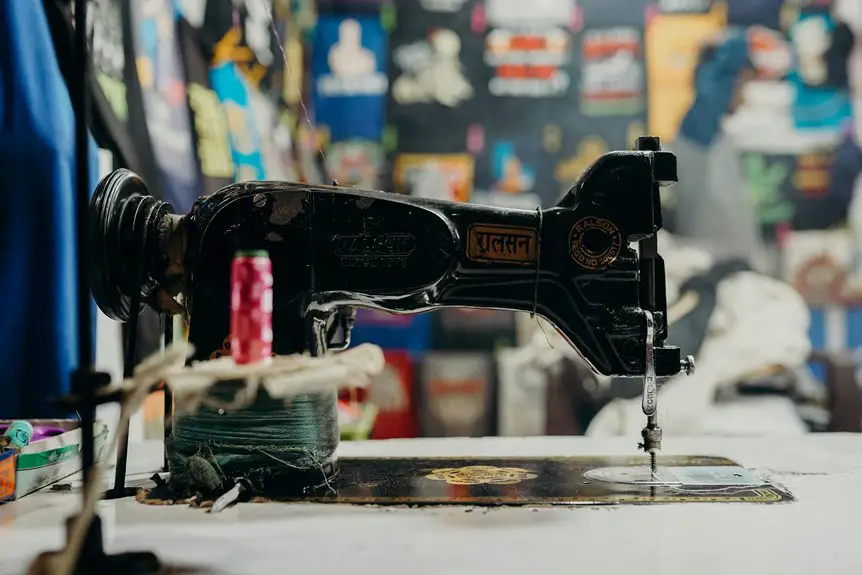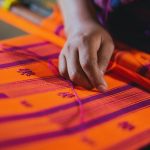You can iron gauze fabric safely by using a low heat setting labeled “delicate” or “synthetic” and avoiding direct steam. Always lay the fabric flat, smooth it gently by hand, and use a pressing cloth to protect the airy weave. Keep the iron’s soleplate clean and glide it lightly without stretching the fabric. For steaming, hold the steamer about six inches away and move it continuously. If you want to keep your gauze soft and wrinkle-free, there are some handy tips and techniques to explore next.
Table of Contents
Key Takeaways
- Yes, gauze fabric can be ironed using a low heat setting labeled “delicate” or “synthetic” to avoid scorching.
- Always use a pressing cloth between the iron and gauze to protect the fabric from direct heat and prevent damage.
- Avoid direct steam on gauze; instead, steam from about 6 inches away while hanging the fabric to relax fibers gently.
- Lay gauze flat on an ironing board, smooth creases by hand first, and glide the iron lightly without applying pressure.
- Test ironing on a small hidden area first, and avoid ironing over embellishments or seams directly to maintain fabric integrity.
Understanding the Characteristics of Gauze Fabric
Although gauze fabric looks delicate, it’s surprisingly durable and breathable. You’ll notice its loosely woven structure, which allows air to pass through easily, making it perfect for warm weather or sensitive skin.
Because gauze is lightweight and slightly textured, it wrinkles easily but also recovers well with gentle handling. You should know that gauze often comes in cotton or cotton blends, so it reacts differently to heat depending on the fiber content.
Since its openness makes it more vulnerable to stretching or distortion, you need to be careful when applying pressure or heat. Understanding these traits helps you handle gauze properly, ensuring you maintain its softness and airy feel without damaging the fabric’s unique texture.
Preparing Gauze Fabric for Ironing
Before you start ironing gauze fabric, you need to prepare it carefully to avoid damage. First, make certain the gauze is clean and completely dry. Any moisture or dirt can lead to unwanted wrinkles or burns.
Ensure gauze is clean and fully dry before ironing to prevent wrinkles or burns.
Lay the fabric flat on a clean, heat-resistant surface like an ironing board. Smooth out any obvious folds or creases by hand to minimize pressure during ironing.
If the gauze is particularly delicate, consider placing a thin cotton cloth or pressing cloth over it to protect the fibers. Avoid stretching or pulling the fabric as you prepare it since gauze is lightweight and prone to distortion.
Taking these steps guarantees that when you iron, the gauze maintains its texture and shape without getting damaged.
Best Iron Settings for Gauze
When ironing gauze, you’ll want to set your iron to a low heat setting, typically labeled as “delicate” or “synthetic.” High temperatures can easily scorch the lightweight fibers or cause them to lose their softness.
Avoid using steam directly as excessive moisture combined with heat might distort the fabric. Make certain your iron’s soleplate is clean to prevent snagging or staining the gauze. If your iron has adjustable steam settings, keep it off or at its lowest level.
Also, consider using a pressing cloth between the iron and the fabric to add extra protection. Always test on a small, inconspicuous area first to guarantee the setting works well without damaging the gauze.
This careful approach preserves the fabric’s airy texture and appearance.
Techniques for Steaming Gauze Fabric
Ironing gauze requires careful temperature control, but steaming offers a gentler alternative that helps maintain its delicate texture.
When you steam gauze, you avoid direct heat contact, reducing the risk of scorching or crushing the fabric’s airy weave. Here’s how to do it right:
- Hold the steamer slightly away from the fabric—about 6 inches—to let the steam relax the fibers without soaking the gauze.
- Move the steamer continuously to prevent moisture buildup in one spot, which can cause wrinkles or distortion.
- Hang the gauze while steaming so gravity helps smooth out creases naturally as the steam penetrates.
Using these techniques, you’ll refresh your gauze fabric safely and keep its soft, breathable quality intact.
Tips to Avoid Damage While Pressing Gauze
Though gauze fabric is lightweight and airy, you need to handle it with care to avoid damage while pressing. Always use a low heat setting on your iron to prevent scorching or melting.
Place a pressing cloth, like a clean cotton towel, between the iron and the gauze to protect its delicate fibers. Avoid applying too much pressure—let the iron glide gently over the fabric.
If your iron has a steam function, use it sparingly to prevent water spots and distortion. Test a small, inconspicuous area first to verify the heat and steam won’t harm the fabric.
Finally, avoid ironing over embellishments or seams directly. By following these steps, you’ll keep your gauze fabric looking fresh without risking tears, burns, or unwanted creases.
Frequently Asked Questions
Can Gauze Fabric Be Machine Washed Before Ironing?
You can machine wash gauze fabric, but use a gentle cycle with cold water to protect its delicate texture. Avoid harsh detergents, and don’t overload the machine. This keeps the fabric soft and ready for ironing.
Is It Safe to Use a Spray Starch on Gauze Fabric?
Using spray starch on gauze fabric is like walking a tightrope—you need caution. You can, but use a light mist to avoid stiffness or damage. Always test a small area first to keep it safe and soft.
How Do You Store Gauze Fabric After Ironing?
After ironing, you’ll want to let gauze fabric cool completely. Then, fold it gently and store it in a breathable cotton bag or container to prevent moisture buildup and keep it fresh and wrinkle-free.
Can Gauze Fabric Be Dyed After Ironing?
Dyeing gauze fabric after ironing is like painting on a dry canvas; you can do it, but the fabric’s texture may affect color absorption. You’ll want to test a small piece first to guarantee even dyeing.
What Types of Garments Are Commonly Made With Gauze Fabric?
You’ll find gauze fabric used in lightweight summer dresses, baby clothes, scarves, and breathable shirts. Its soft, airy texture makes it perfect for casual wear and cozy wraps, keeping you comfortable in warm weather.
- The History of Selvedge Denim: From Workwear Staple to Fashion Icon - June 24, 2025
- What to Wear With Selvedge Jeans: the Ultimate Styling Companion - June 24, 2025
- How to Identify the Selvedge Edge on Any Fabric - June 24, 2025







